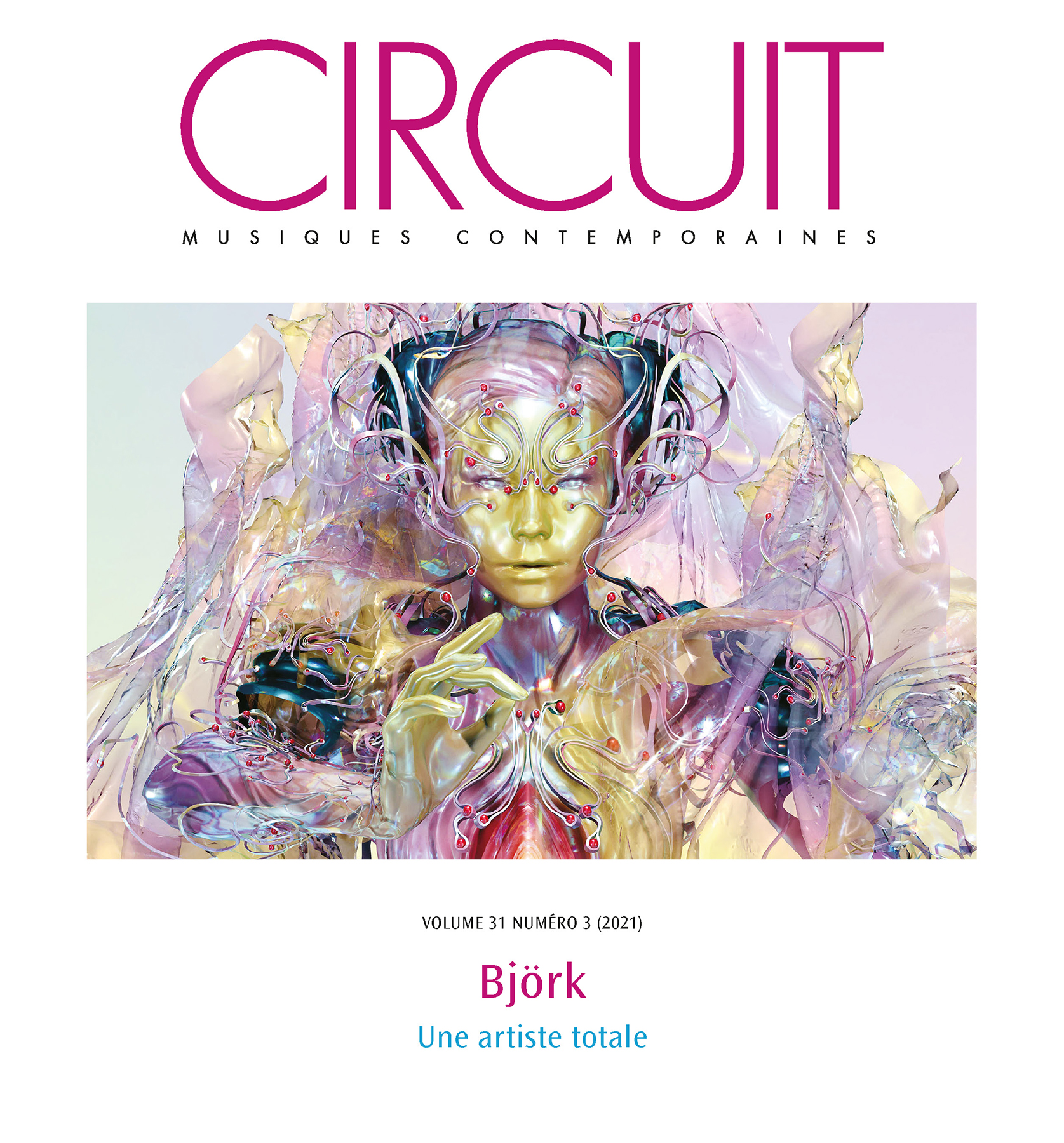Résumés
Abstract
Björk’s Vulnicura (2015) engages the theme of the dissolution of a long-term relationship. As with much of Björk’s music, most listeners are drawn to her voice and the interplay between lyrics and vocal delivery. This article explores vocal prosody, conceived as the pacing and flow of delivery, in three tracks—“Lionsong,” “Black Lake,” and “Family”—through aspects of discontinuous phrasing, varied metric placement, melismatic embellishment, consonantal articulation, and vocal layering. Thinking about the sonic materiality of the voice broadly—and more specifically, understanding the prosodic aspects of Björk’s delivery on Vulnicura—help us probe the album’s expressivity and grasp the specific material elements that facilitate its emotional content. Though most prosodic elements on this album reflect Björk’s singing style more broadly, some—such as discontinuous phrasing—are intensified to specifically serve this album’s emotive aims.
Keywords:
- Björk,
- voice,
- prosody,
- Vulnicura,
- phrasing
Résumé
L’album Vulnicura (2015) de Björk aborde le thème de la dissolution d’une relation à long terme. Comme pour une grande partie de la musique de l’artiste, les auditeurs sont attirés par sa voix et par l’interaction entre les paroles et le débit vocal. Cet article explore la prosodie en tant que rythme et flux de l’élocution dans trois morceaux – « Lionsong », « Black Lake » et « Family » – à travers les différents aspects que sont la discontinuité du phrasé, la variabilité du placement métrique, l’embellissement mélismatique, l’articulation consonantique et la superposition de strates vocales. Réfléchir à la matérialité sonore de la voix en général – et, plus spécifiquement, comprendre les aspects prosodiques de la prestation de Björk sur Vulnicura – nous aide à mieux sonder l’expressivité de l’album et à saisir les éléments matériels précis qui facilitent le déploiement de son contenu émotionnel. Bien que la plupart des éléments prosodiques de ces enregistrements reflètent plus largement le style de chant individuel de Björk, certains – comme la discontinuité du phrasé – sont encore plus intensifiés pour servir spécifiquement les objectifs émotionnels de cet album.
Mots-clés :
- Björk,
- voix,
- prosodie,
- Vulnicura,
- phrasé
Parties annexes
Bibliography
- Baker, Andrea (2016), “Björk, Digital Feminist Diva, Helps Cure Our Wounds in a Visceral Sydney Show,” August 1, The Conversation, https://theconversation.com/bjork-digital-feminist-diva-helps-cure-our-wounds-in-a-visceral-sydney-show-60324 (accessed June 26, 2021).
- Boak, Sarah (2019), “ ‘Imagine What My Body Would Sound Like’: Embodiment, Nature and Sound in the Work of Björk Guðmundsdóttir,” in Þorbjörg Daphne Hall, Nicola Dibben, Árni Heimir Ingólfsson and Tony Mitchell (eds.), Sounds Icelandic: Essays on Icelandic Music in the 20th and 21st Centuries, Sheffield, Equinox Publishing, pp. 194–207.
- Brozzoni, Vera (2017), “Completing the Mystery of Her Flesh: Love, Eroticism, and Identity in Björk’s Videos,” in Gina Arnold, Daniel Cookney, Kirsty Fairclough and Michael Goddard (eds.), Music/Video: Histories, Aesthetics, Media, New York, Bloomsbury Academic, pp. 109–20.
- Coscarelli, Joe (2015), “Björk Album for March,” January 15, The New York Times, vol. 164, No. 56747, p. C2.
- Cox, Jamieson (2015), “Björk, Vulnicura,” February 7, Billboard, vol. 127, No. 3, p. 47.
- Dibben, Nicola (2009), Björk, Bloomington, Indiana University Press.
- Ferrett, D (2020), Dark Sound: Feminine Voices and Sonic Shadow, New York, Bloomsbury Academic.
- Guzmán, Isaac (2015), “Swan Song,” March 16, Time Magazine, vol. 185, No. 9, pp. 58–61.
- Hermes, Will (2015), “Björk Finds the Beauty in a World of Pain,” Rolling Stone, No. 1228, p. 52.
- Mackay, Emily (2017), Björk’s Homogenic, New York, Bloomsbury Academic.
- Magnússon, Haukur S. (2015), “Björk’s Folk Music,” February 6, The Reykjavik Grapevine, http://grapevine.is/mag/feature/2015/02/06/bjorks-folk-music (accessed July 6, 2021).
- Malawey, Victoria (2020), A Blaze of Light in Every Word: Analyzing the Popular Singing Voice, New York, Oxford University Press.
- Marsh, Charity and West, Melissa (2003), “The Nature/Technology Opposition Dismantled in the Music of Madonna and Björk,” in René T. A. Lysloff and Leslie C. Gay Jr. (eds.), Music and Technoculture, Middletown, Wesleyan University Press, pp. 182–203.
- Melançon, Jérôme and Carpenter, Alexander (2017), “The Subject of Music as Subject of Excess and Emergence: Resonances and Divergences between Slavoj Žižek and Björk Guðmundsdóttir,” International Journal of Žižek Studies, vol. 11, No. 3, pp. 203–28.
- Omry, Keren (2016), “Bodies and Digital Discontinuities: Posthumanism, Fractals, and Popular Music in the Digital Age,” Science-Fiction Studies, vol. 43, No. 1, pp. 104–22.
- Pareles, Jon (2015a), “A Heart Broken and Dissected,” January 22, The New York Times, vol. 164, No. 56754, pp. C1–C5.
- Pareles, Jon (2015b), “Sometimes Heartbreak Takes a Hostage,” February 1, The New York Times, vol. 164, No. 56764, p. AR1.
- Tamarkin, Jeff (2015), “Vulnicura,” Relix, vol. 42, No. 3, p. 66.
- Ware, Tony (2015), “Vulnicura,” Electronic Musician, vol. 31, No. 4, p. 44.
- Whiteley, Sheila (2005), Too Much Too Young: Popular Music, Age and Gender, London, Routledge.
Discography
- Björk (2015), “Black Lake,” YouTube video, https://youtu.be/YGn1pJIpZw8 (accessed June 26, 2021).
- Björk (2015), Vulnicura, One Little Indian, cd 67572-1.

